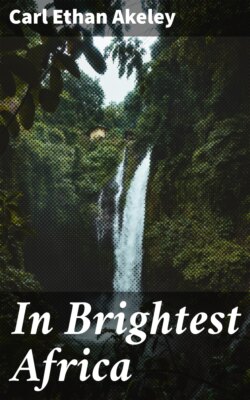Читать книгу In Brightest Africa - Carl Ethan Akeley - Страница 3
FOREWORD
ОглавлениеI have written this Foreword, not after reading the manuscript of the volume thoroughly, but after a quarter of a century acquaintance with the experiences, thoughts, and ideals of the author himself. This is the daybook, the diary, the narrative, the incident, and the adventure of an African sculptor and an African biographer, whose observations we hope may be preserved in imperishable form, so that when the animal life of Africa has vanished, future generations may realize in some degree the beauty and grandeur which the world has lost.
Sculptor and Biographer of the vanishing wild life of Africa—I do not feel that I can adequately and truthfully characterize Carl E. Akeley better than in these words. I have always maintained that he was a sculptor, that sculpture was his real vocation, in which taxidermy was an incidental element. The sculptor is a biographer and an historian. Without sculpture we should know far less of the vanished greatness of Greece than we do. Through sculpture Carl E. Akeley is recording the vanishing greatness of the natural world of Africa. We palæontologists alone realize that in Africa the remnants of all the royal families of the Age of Mammals are making their last stand, that their backs are up against the pitiless wall of what we call civilization. Human rights are triumphing over animal rights, and it would be hard to determine which rights are really superior or most worthy to survive.
Akeley came twenty-seven years ago into the midst of this unequal contest between the flesh and blood of the animal kingdom and the steel and lead of the sportsman, of the food and ivory hunter, and his sympathies were all on the animal side in the fight. If his sympathies had been on the human side he could not be the biographer of the African vanishing world who speaks in the pages of this volume, lost in admiration of the majesty of the elephant, the unchallenged reign of the lion, the beauty and grace of the antelope, the undaunted courage of the buffalo, and, last but not least, of certain splendid qualities in the native African hunter. We know of only one other sculptor who has immortalized the African Negro in bronze; this is Herbert Ward, whose splendid life work is now in the United States National Museum.
Similarly, Carl E. Akeley's life work will be assembled in the African and Roosevelt Halls of the American Museum, in human bronzes, in a great group of the elephant, in rhinoceroses and gorillas, each group representing his unerring portrayal of the character of the animal and his sympathetic admiration of its finest qualities. It is in making close observations for these groups that he has lived so long in Africa and come very close to death on three occasions. We may find something base in animal nature if we seek it; we may also find much that is excellent and worthy of emulation. In this respect animal nature is like human nature—we may take our choice. The decadent sculptor and the decadent writer may choose the wrong side in human nature, and the sensational writer may choose the wrong side in animal nature; Akeley has chosen the ennobling side and does not dwell on the vices either of the animals or of the natives but on their virtues, their courage, defence of their young, devotion to the safety of their families—simple, homely virtues which are so much needed to-day in our civilization.
Truthfulness is the high note of the enduring biographer of animal life as well as of human life. "Set down naught in malice, nothing extenuate" is an essential principle in the portrayal of vanishing Africa as it is in our portrayal of the contemporary manners and customs of modern society; to know the elephant, the lion, the antelope, the gorilla as they really are, not as they have been pictured by sensational writers who have never seen them at close range or who have been tempted to exaggerate their danger for commercial reasons. Akeley's work on the gorilla is the latest and perhaps his best portrayal of animal life in Africa as it really is. He defends the reputation of this animal, which has been misrepresented in narrative and fiction as a ferocious biped that attacks man at every opportunity, abducts native women as in the sculptures of Fremiet, a monster with all the vices of man and none of the virtues. For this untruthful picture Akeley substitutes a real gorilla, chiefly a quadruped in locomotion, not seeking combat with man, ferocious only when his family rights are invaded, benign rather than malignant in countenance. Thus he explodes the age-long gorilla myth and we learn for the first time the place in nature of this great anthropoid and come to believe that it should be conserved and protected rather than eliminated. In other words, the author shows that there are good grounds for the international movement to conserve the few remaining tribes of the gorilla.
Akeley has come into closest touch with all these animals in turn, even at great personal risk, always leaving with increased rather than diminished admiration for them. This quality of truthfulness, combined with his love of beauty of the animal form—beauty of hide, of muscle, of bone, of facial expressions—will give permanence to Akeley's work, and permanence will be the sure test of its greatness.
Henry Fairfield Osborn.
July 27, 1923.
American Museum.
